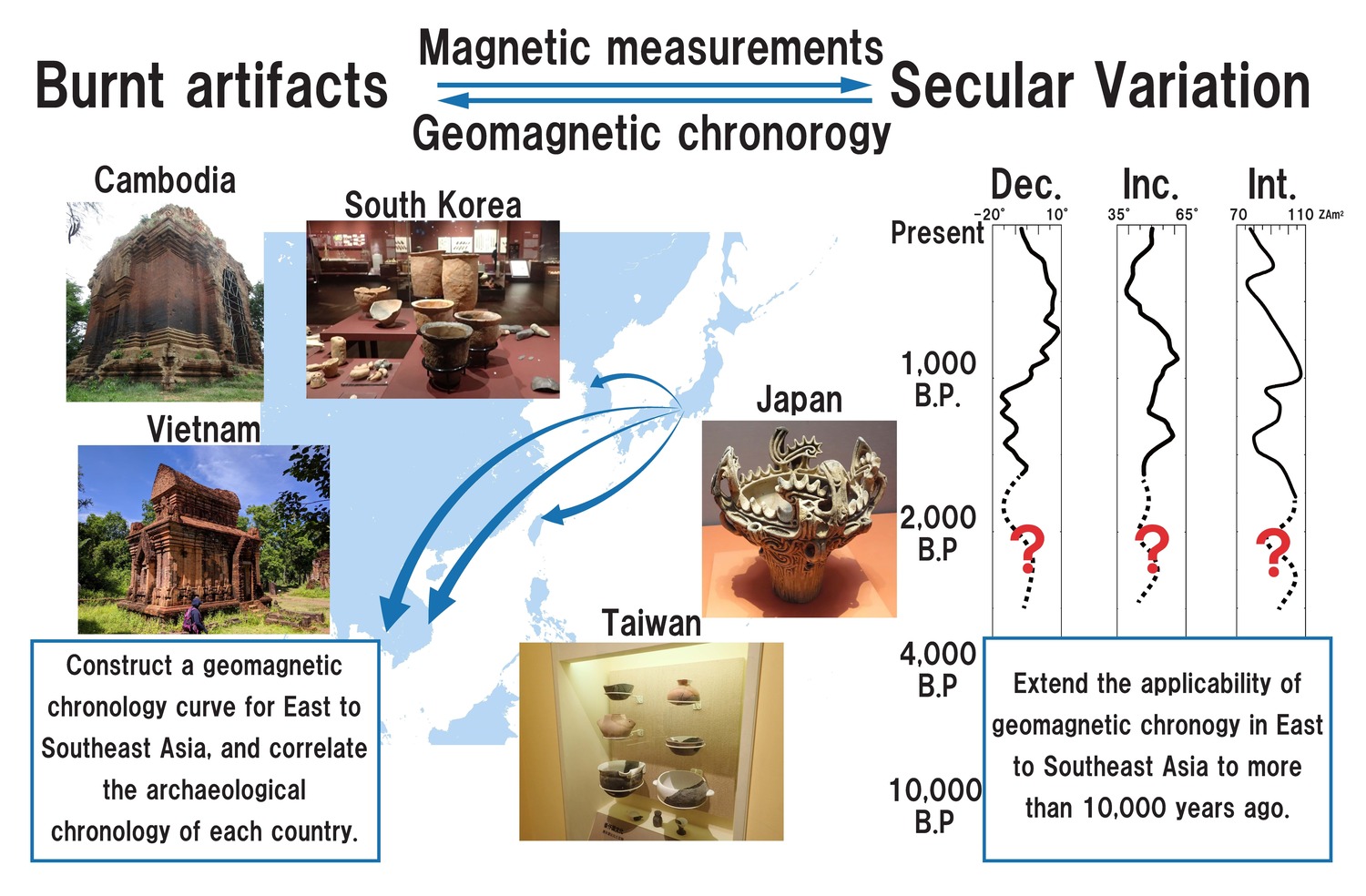Archaeomagnetic Research Group
Expanding Paleomagnetic Dating Methods and Fostering Integrated Research with the Humanities
In collaboration with the Advanced Asian Archaeological Research Center, Kyushu University, Institute for Space-Earth Environmental Research (ISEE), Nagoya University will advance efforts to collect, organize, and conduct magnetic analyses of archaeological materials from East Asia to Southeast Asia. This initiative aims to extend the application of paleomagnetic dating methods from the current limit of approximately 2,000 years to over 10,000 years ago, enabling broader comparisons of archaeological timelines across different countries. Furthermore, by collaborating with the "Severe Disasters and Chronometry Group," we will enhance the precision of this paleomagnetic dating method through comparisons with carbon-14 dating. Our research will also promote transdisciplinary collaboration of the humanities and sciences, particularly in the fields of archaeology and anthropology, by applying advanced magnetic analysis techniques.

Members
Institute for Space-Earth Environmental Research, Nagoya University
Masayo Minami
Office Manager, ISEE Vice Director, Professor
Office for the Promotion of Transdisciplinary Network (OPTN) / Division for Chronological Research / Center for International Collaborative Research / Office for the Development of Interdisciplinary Research Strategy
Isotope geochemistry, Carbon-14 dating, Geochronology
My research focuses on radioisotope-based geochronology and geochemistry, emphasizing the development of advanced sample preparation methods for precise and accurate carbon-14 dating of geological and archaeological samples. I also investigate paleoclimatic changes and environmental dynamics using stable isotopes as tracers. This includes creating isotopic geochemical maps for provenance studies and historical analyses.I aim to further promote collaboration with researchers from diverse fields, both domestically and internationally.

Kyushu University, Advanced Asian Archaeological Research Center
Masao Ohno
Professor
Archaeomagnetism, Rock Magnetism
I am working to reconstruct past fluctuations in the Earth’s magnetic field to apply them to estimate the ages of ruins, through archaeomagnetic study of kilns and pottery from ruins, as well as paleomagnetic study of rocks and sediments. I also study paleoenvironmental changes and seafloor resources through rock magnetic analysis of marine sediments.
Graduate School of Integrated Sciences for Global Society, Kyushu UniversityChie Kato
Assistant Professor
Division of Earth Sciences, Department of Environmental Changes, Faculty of Social and Cultural Studies, Kyushu University
Paleomagnetism, Rock magnetism
My major research field is paleomagnetism, especially paleointensity measurements on geological samples such as lavas, intrusive rocks, and single silicate crystals, and archeological samples. I am also conducting basic researches on the use of magnetic minerals, which are sensitive indicators of temperature and redox state, to enable inferring the heating conditions of burnt archaeological artifacts and the formation environment of hydrothermal deposits based on magnetic measurements.

Yu Kitahara
Designated Assistant Professor
Archaeology in Vietnam, Magnetic Analysis
I am conducting research focused on archaeology in Vietnam, particularly on elucidating the Sa Huỳnh - Chămpa culture in Central region and the Óc Eo culture in Southern region. My research emphasizes the transition of material culture, mainly bricks and potteries, as well as the relationship between ancient human activities and the natural environment. In addressing these issues, I primarily utilize techniques of magnetic analysis, including archaeomagnetism, as main analytical tools to advance my research.
Hirotaka Takahashi
Research Assistant
Marine Core Research Institute, Kochi University
Yuhji Yamamoto
Professor
Paleomagnetism, Rock magnetism
By performing various magnetic analyses on archaeological materials such as earthenware and baked clay, as well as geological samples such as volcanic rocks and seabed sediments, we are able to reconstruct the strength and direction of the Earth's magnetic field at the time these materials were formed, as well as estimate the environment in which they were formed. In this program, we will work on the construction of a standard curve of long-term changes in geomagnetic direction and intensity that will contribute to archaeomagnetic dating of archaeological materials from East Asia since the Holocene, and their application.

Research Institute of Frontier Science and Technology, Okayama University of Science
Tadahiro Hatakeyama
Professor
Paleomagnetism, Rock magnetism
I research in archaeomagnetism and archaeo-rock magnetism, which is the application of paleomagnetism and rock magnetism, a branch of geoscience, to archaeology. I collect samples of burned materials, ex. pottery and the kilns in which they were fired, and investigate the direction and strength of the Earth's magnetic field in the past and the iron minerals they contain through the paleomagnetic and rock magnetic methods. Our goal is to develop and implement methods for estimating changes in the Earth's magnetic field and the age of the samples, and to reconstruct the environment of the time period of the archaeological site through changes in the iron minerals.